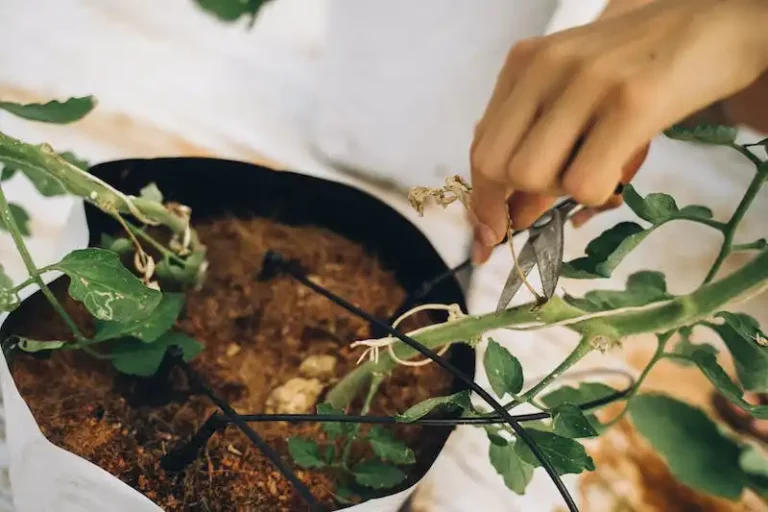If you’re looking for a colorful addition to your garden, consider growing the copperleaf plant (Acalypha wilkesiana). This gorgeous shrub, also known as copperleaf or the rosary vine, belongs to the Acalypha family and is native to the Pacific Islands. With its vibrant and fuzzy foliage, the copperleaf plant is sure to grab attention.
Copperleaf plants thrive in warm and frost-free climates, making them ideal for outdoor growing. They prefer bright, indirect light and should be kept in a shaded area if grown indoors. These plants have specific soil requirements and need well-draining, fertile soil to grow successfully.
When it comes to watering, copperleaf plants need plenty of moisture. However, overwatering can cause root rot and other issues. It’s important to keep the soil slightly moist, but not soaked. Regularly check the moisture level and adjust your watering accordingly.
Pruning is another important aspect of copperleaf plant care. Regularly trim and shape the branches to maintain a compact and tidy form. This will also encourage new growth and keep the plant looking its best.
One of the most prominent features of the copperleaf plant is its year-round colorful foliage. The leaves display a blend of bright green, copper, and red, adding a touch of vibrancy to any garden or landscape design. In addition to the ornamental foliage, copperleaf plants also produce small, inconspicuous flowers and fruits.
To grow copperleaf plants, it’s important to consider their temperature needs. They thrive in warm climates and are not tolerant of frost. If you live in a colder region, it’s best to grow them in containers so you can bring them indoors during the winter months.
Overall, copperleaf plants are relatively low-maintenance and can be a stunning addition to any garden or indoor space. With their unique fuzzy foliage and vibrant colors, they are sure to catch your eye. Whether you’re a beginner gardener or a seasoned plant enthusiast, the copperleaf plant is definitely worth considering.
Acalypha amentacea subsp wilkesiana Copperleaf
Acalypha amentacea subsp wilkesiana, commonly known as Copperleaf, is a stunning plant characterized by its vibrant copper-colored foliage. It belongs to the family Acalyphaceae and is native to some parts of the world. The plant features fuzzy leaves and a woody trunk that can grow to several feet in length.
Copperleaf plants can be grown both indoors and outdoors, depending on the climate and temperature requirements. They are typically used as accent plants in gardens or as decorative houseplants due to their unique copper-colored leaves. When grown outdoors, they thrive in full sun or partial shade and require a frost-free environment.
In terms of care, Copperleaf plants have general requirements similar to other houseplants. They need well-draining soil and should be watered regularly without allowing the soil to become waterlogged. The plants also benefit from regular fertilizing, typically during the growing season. When grown indoors, they prefer bright, indirect light and can be placed near a north-facing window.
Propagation of Copperleaf plants can be done through stem cuttings. The cuttings should be taken from healthy, mature plants and rooted in water or a well-draining potting mix. The cuttings will develop roots within a few weeks and can then be planted in a container or outdoor garden.
While Copperleaf plants are generally low-maintenance, they can be susceptible to pests and diseases. Common pests that can affect these plants include aphids and mealybugs. If an infestation occurs, it is best to treat it promptly using appropriate pest control methods.
In terms of design, Copperleaf plants can be used to add a pop of color to gardens or indoor spaces. Their vibrant copper-colored foliage stands out among green plants, creating a stunning visual contrast. They can be combined with plants that have contrasting colors or textures to create a visually appealing arrangement.
In conclusion, Acalypha amentacea subsp wilkesiana, or Copperleaf, is a beautiful plant with copper-colored foliage. Whether grown indoors or outdoors, it requires well-draining soil, regular watering, and bright, indirect light. With proper care and attention, Copperleaf plants can thrive and add a touch of color to any space.
| Plant Name | Acalypha amentacea subsp wilkesiana |
|---|---|
| Family | Acalyphaceae |
| Native | Some parts of the world |
| Description | A plant with fuzzy leaves and a woody trunk |
| Leaf Color | Copper |
| Light Requirements | Bright, indirect light |
| Watering Needs | Regular watering, well-draining soil |
| Propagation | Stem cuttings |
| Indoor/Outdoor | Both |
| Pests | Aphids, mealybugs |
| Climate | Frost-free environment |
General Information
Acalypha copperleaf plants, also known as Acalypha wilkesiana, are tropical perennial shrubs native to the Pacific Islands. They belong to the family Euphorbiaceae and are known for their vibrant and colorful foliage. The leaves of the copperleaf plant can range in color from red and pink to green and even bronze. Some popular varieties include Acalypha wilkesiana ‘Copperleaf’, Acalypha wilkesiana ‘Swiss Cottage’, and Acalypha wilkesiana ‘Aureum’.
These plants can be grown both indoors and outdoors, depending on the climate. In a frost-free area, they can be grown outdoors year-round, while in colder regions, they can be grown as houseplants. When grown indoors, they thrive in bright, indirect light near a window. Outdoors, they prefer a partially shaded area.
Copperleaf plants are relatively easy to care for and can be a great addition to any garden or indoor space. Here are some general tips for growing and caring for Acalypha copperleaf plants:
| Light: | Place the copperleaf plant in a bright location with indirect sunlight. |
| Watering: | Water the plant regularly, keeping the soil moist but not waterlogged. |
| Soil: | Use a well-draining, fertile soil mix for planting and repotting. |
| Fertilizer: | Feed the plant with a balanced, all-purpose fertilizer during the growing season. |
| Pruning: | Prune the plant to maintain its shape and encourage bushy growth. |
| Pests: | Watch out for pests such as aphids, spider mites, and whiteflies. Use appropriate pest management techniques if needed. |
| Diseases: | Copperleaf plants are generally resistant to diseases, but they can occasionally be affected by fungal infections. Proper watering and good air circulation can help prevent diseases. |
With their eye-catching foliage, Acalypha copperleaf plants can be used as a focal point in garden design or as indoor statement plants. They can be grown in containers or planted directly in the ground. In the garden, they can be combined with other tropical plants for a stunning display.
If you have any questions or need more information about caring for Acalypha copperleaf plants, consult a plant care guide such as Guide-to-Houseplants.com or reach out to a local gardening expert.
Description
The Acalypha wilkesiana, commonly known as the Copper Leaf plant, is a vibrant and eye-catching shrub that belongs to the Acalypha family. This plant is native to the Pacific Islands and grows well both indoors and outdoors, making it a popular choice for garden enthusiasts.
The Copper Leaf plant is characterized by its long, pointed leaves that come in a variety of contrasting and colorful combinations. The leaves can range from deep purple to green with pink veins, creating a striking visual appeal. The plant also produces small, inconspicuous flowers that are followed by fruit.
Growing this plant is relatively simple, and it thrives in both full sun and partial shade. When growing it indoors, place the Copper Leaf plant in a well-lit area, such as a north-facing window. It requires regular watering, allowing the soil to dry out between waterings. Additionally, providing the plant with a balanced fertilizer can help it thrive.
Propagating the Copper Leaf plant can be done through stem cuttings. Simply cut a healthy stem with a few leaves and place it in water or moist soil until it develops roots. Once the roots have developed, the new plant can be potted and cared for similarly to the parent plant.
When the Copper Leaf plant is fully grown, it can reach a height of up to 6 feet with branches that spread outwards. Pruning can help control the size and shape of the plant. It is also important to keep an eye out for common pests and diseases that may affect the plant’s health.
In recent years, the Copper Leaf plant has gained popularity as a houseplant and can be enjoyed year-round. Its contrasting and colorful foliage makes it an ideal choice for adding a pop of color to any indoor space. Additionally, its easy care requirements and attractive appearance make it a favored plant among both beginner and experienced gardeners.
Overall, the Copper Leaf plant, or Acalypha wilkesiana, is a beautiful and low-maintenance shrub that can brighten up any garden or indoor space. With its eye-catching foliage and simple care requirements, it is a popular choice for gardeners looking to add a touch of color and vibrancy to their landscapes.
Foliage
The foliage of the copper leaf plant, known scientifically as Acalypha, is one of its most remarkable features. The leaves of the Acalypha adansonii subsp. amentacea, also called the Swiss cheese plant or watermelon ceropegia, are green with copper accents. Other varieties, like the Acalypha aurum and Acalypha wilkesiana, have colorful leaves in shades of pink, copper, and red.
The leaves of the copper leaf plant can be large and showy, making them a great accent in any garden or indoors as a houseplant. They are typically fuzzy and have a slightly heart-shaped or oval shape, depending on the variety. The foliage of the Acalypha copperleaf can even cover the stems, giving the plant a lush and full appearance.
Growing copper leaf plants can be relatively simple, given the right conditions. They thrive in well-draining soil and prefer partially shaded areas, although they can tolerate full sun as long as they are given plenty of water. The Acalypha copperleaf is also quite adaptable and can grow indoors as long as it receives enough light.
When planting copper leaf plants, it is important to consider their size and form. Some varieties can grow quite large and may require regular pruning to maintain their shape. Additionally, copper leaf plants can be propagated easily by stem cuttings or by moss propagation. However, it is worth noting that some varieties, like the Acalypha wilkesiana, are more challenging to propagate than others.
Copper leaf plants are generally low-maintenance, but they may benefit from the occasional application of fertilizer to keep them healthy and vibrant. However, be cautious not to over-fertilize, as this can cause the leaves to turn brown and drop. Additionally, copper leaf plants can be prone to diseases and pests, so it’s important to stay vigilant and provide them with the proper care and attention.
In summary, the foliage of the copper leaf plant is its standout feature. With their colorful and vibrant leaves, these plants can be a beautiful addition to any garden or indoor space. Growing copper leaf plants requires some considerations, such as proper lighting, watering, and pruning. However, with the right care and attention, the foliage of the copper leaf plant can truly thrive and provide an eye-catching display.


